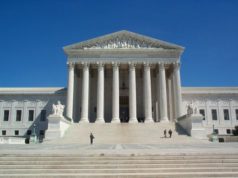Table of Contents

The Supreme Court Labor Clause: Protecting the Rights of Workers
The Supreme Court Labor Clause is a vital component of labor laws in the United States that protects the rights of workers. This clause has been shaped by numerous court cases and has evolved over time to reflect the changing labor landscape.
The Labor Clause, also known as the “non-waiver of rights” clause, is a provision in collective bargaining agreements that ensures employees’ federally protected rights are not waived. It is a critical part of labor law that is intended to prevent employers from taking advantage of workers or depriving them of their rights.
History of the Labor Clause
The Labor Clause traces back to the early 1930s, a period of high unemployment and economic insecurity. During this time, organized labor was becoming more prevalent, leading to the establishment of laws that protect workers’ rights.
In 1932, the legal framework for labor relations was established with the National Industrial Recovery Act (NIRA). This act brought about the first federal effort to regulate private industry and included provisions that protected workers’ rights to join a union, engage in collective bargaining, and strike.
However, the NIRA was struck down by the Supreme Court in the case of Schechter Poultry Corporation v. United States, which ruled that the law was an unconstitutional delegation of legislative power. This ruling spurred Congress to pass the National Labor Relations Act (NLRA) in 1935, which established the right of workers to unionize and engage in collective bargaining.
The NLRA included the Labor Clause, which was intended to ensure that workers’ rights were not waived during bargaining. This clause barred employers and unions from making agreements that waived workers’ rights to organize, bargain collectively, or strike. The Labor Clause was thus seen as an essential part of the NLRA and a critical protection for workers nationwide.
Interpretation of the Labor Clause
The Labor Clause has been interpreted in various ways by courts and has evolved over time. In the early years of its existence, courts narrowly construed the clause, limiting its application and scope.
For example, in the 1947 case of Lincoln Mills of Alabama v. Textile Workers Union, the Supreme Court upheld the enforcement of a contract that included a provision waiving the right to strike. The Court held that the Labor Clause did not prevent unions from agreeing to such a provision, as long as it did not conflict with other parts of the NLRA.
However, in later cases, courts have taken a broader view of the Labor Clause, recognizing its importance in protecting workers’ rights. For example, in NLRB v. Magnavox Co., the Ninth Circuit Court of Appeals held that a clause in a collective bargaining agreement prohibiting workers from testifying against the company violated the Labor Clause. The court stated that the clause constituted a waiver of employees’ federally protected rights and was thus unenforceable.
Similarly, in Allied Chemical & Alkali Workers of America v. Pittsburgh Plate Glass Co., the Supreme Court struck down a collective bargaining agreement that required workers to submit to lie detector tests. The Court held that the agreement violated the Labor Clause, as it constituted a waiver of employees’ right to be free from unreasonable searches and seizures.
In modern times, courts have continued to interpret the Labor Clause to protect workers’ rights. For example, in the recent case of Unite Here Local 11 v. Sage Hospitality Resources, the Ninth Circuit held that a provision in a collective bargaining agreement requiring employees to waive their rights to bring claims against the employer violated the Labor Clause. The court held that such a provision constituted a waiver of employees’ rights and was thus unenforceable.
Importance of the Labor Clause Today
The Labor Clause continues to be an essential component of labor law today, protecting workers’ rights and ensuring that they are not exploited or deprived of their rights. Because of the clause, employers cannot require workers to waive their federally protected rights, ensuring that employees have the freedom to organize, bargain collectively, and strike.
In recent years, the Labor Clause has come under attack by employers and policymakers who seek to weaken labor protections. Some employers have sought to implement so-called “right-to-work” laws, which prohibit unions from requiring workers to pay union dues. These laws effectively weaken unions’ bargaining power and undermine the Labor Clause by making it more difficult for unions to protect workers’ rights.
Furthermore, the Trump administration has sought to weaken the Labor Clause through various regulatory changes. In 2018, the Department of Labor released a proposal that would allow employers to waive workers’ rights to sue over workplace violations. The proposal has been criticized by labor advocates and is currently being challenged in court.
Despite these challenges, the Labor Clause remains an essential protection for workers. It ensures that employers cannot force employees to waive their rights and helps to promote a fair and just workplace. The Labor Clause helps to ensure that workers receive fair wages, benefits, and working conditions and helps to protect against exploitation and discrimination.
Conclusion
The Supreme Court Labor Clause is a critical component of labor law that protects workers’ rights. It has evolved over time to reflect the changing labor landscape and has been interpreted by courts to ensure that workers’ rights are not waived during collective bargaining.
Today, the Labor Clause continues to be an essential protection for workers, ensuring that they are not exploited or deprived of their rights. While challenges to the Labor Clause persist, its importance in promoting a fair and just workplace cannot be overstated.
Labor issues have been around for quite a long time within the United States. It represents an aspect of life that people must come to grips with in order to make a living
in most cases. United States labor law is comprised of both Federal and State laws that attempt to provide a clear and standard basis by which individuals may be afforded rights for employment. Inclusions are composed of workers’ rights to organize as well as their rights to protection as employees under the mercy of many powerful employers.
In general, you may expect to find that labor laws differ from the Federal to the State levels of government. The Federal Government specifies increased limitations in relation to employee rights, for instance, in comparison to that of local and State levels of legislature. In addition, distinctions may be made in terms of earnings, as well as working environment conditions. While the Federal Government places limits on earnings as well as overtime specifications, State and local governments may expand these rights even further.
One area of interest for all levels of Government includes that of the issue of discrimination within the workplace. One example of a Federal/State Government understanding is through which the Federal Legislature gives State levels the power to go forward with their own statutes dealing with discrimination as long as they maintain equal protections to that of the Federal Government.
An example of a Supreme Court case that dealt with such practices concerned with “unemployment benefits” was Employment Division v. Smith. In this case, the Supreme Court ruled that it was unconstitutional for the State to prevent the practices of religion. One of the first laws to forbid racial discrimination was the Fair Employment Act. Subsequent legislation has been attached to the Equal Employment Opportunity Commission. This Commission is responsible for the institution and practice of “anti-discrimination laws”. Two important Acts went so far as to work with one nullifying the other.
While the Sherman Antitrust Act of 1890 was passed with the purpose of putting down unions, describing them as illegal aggregations, yet another Act overrode it. This was the statute entitled the Clayton Antitrust Act of 1914. This Act made sure to specify that unions not be labeled as illegal any longer under antitrust laws.
Another addition to the advent of combatting labor issues was that of Child Labor Amendments.These Amendments set forth to add text to the Constitution that specified specific stipulations. Congress was now given the authority to impose regulations on the labor in which individuals under the age of 18 are allowed to engage. Following such ratification, children had garnered the appropriate protection that they deserved in connection to labor laws within the United States.

























